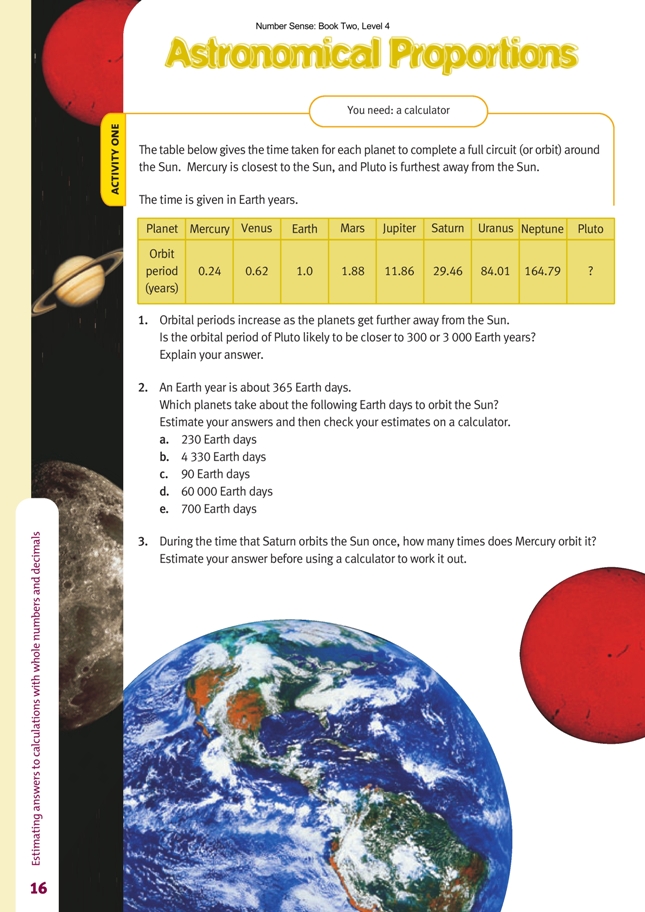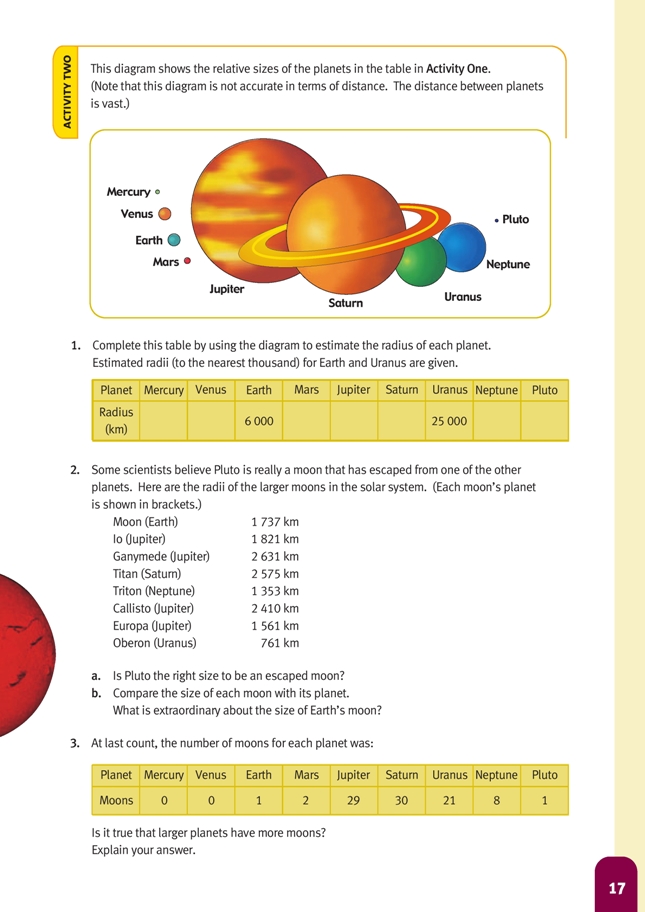This is a level 5 number activity from the Figure It Out series. It relates to Stage 8 of the Number Framework.
A PDF of the student activity is included.
Click on the image to enlarge it. Click again to close. Download PDF (743 KB)
solve problems involving ratios
use rounding to solve proportion problems
A calculator
Activity One
One approach to question 1 would be to consider the ratios of orbit periods for neighbouring planets to see how the periods are increasing. For example, the ratio of orbit periods for Uranus and Saturn is 84.02 : 29.46, or roughly two times as long. This suggests that Pluto’s orbit period might be roughly two or three times as long as Neptune’s, which means that 3 000 Earth years would be a highly improbable time for Pluto to take to circle the Sun. The more likely time is 300 years. In fact, as the answer indicates, the time taken by Pluto is considerably less than 300 years. It has been calculated as 247.92 Earth years.
In question 2, the benchmark figure is the Earth’s 365 days to circle the Sun. Most of the periods listed in question 2 can be matched to the planets by informed estimation. For example, the shortest number of Earth days listed is 90, a time that is almost certainly that of Mercury’s orbit because it is closest to the Sun. This can be checked, using a calculator, by finding what decimal fraction 90 is of 365. The result (90 ÷ 365) is 0.24. This coincides with the Earth year for Mercury on the table, so Mercury must be the planet that takes about 90 days.
The next highest number of Earth days is 230. This is less than the time it takes Earth to orbit the Sun, so logic suggests that this is the time taken by Venus. To check, once again find the decimal fraction (230 ÷ 365), which is 0.63. This is very close to the figure on the table for Venus. The students then have three orbit periods left to match to the remaining six planets on the table. In each case, the orbit period is
greater than that of Earth, so the best strategy will be to estimate how many times 365.25 goes into the number given. For example, the 700 day orbit is almost twice Earth’s period. The table reveals that Mars takes almost twice as long (1.88 years) as Earth to orbit the Sun. A calculator check shows that 700 ÷ 365 is 1.9, which is very close to the 1.88 years on the table, so Mars is confirmed as the correct choice. The figures of 4 330 and 60 000 can be approached in the same way.
In question 3, the students need to consider two figures, the times taken by Mercury and Saturn to orbit the Sun. The data on the table reveal that Mercury orbits the Sun in approximately one-quarter of the year or four times each year. It also shows that Saturn takes approximately 30 years to orbit the Sun. This means that Mercury orbits the Sun approximately 4 x 30 times, that is, 120 times, for every orbit by Saturn. A calculator check (29.46 ÷ 0.24) shows that the figure, based on the data in the table, is 122.75 (a figure that is very close to the estimate).
Activity Two
In question 1 of this activity, the students need to compare the planets with either Earth or Uranus. Although the question asks for estimates of the radii of the planets, the students may find it easier to compare the diameters. This will not make any difference for comparative purposes. The students can either estimate by sight or use a ruler to get better estimates. For example, the diameter of Mercury appears to be about onethird that of Earth, so the radius will also be one-third, namely, about 2 000 kilometres. Likewise, Saturn appears to be a bit under two and a half times that of Uranus. Two and a half times 25 000 is about 62 000, so the actual radius could be estimated to be a bit less than 60 000 kilometres. (Note that the Answers also
give the actual radius of each planet in kilometres.)
Question 2 involves comparing the radius of Pluto (obtained in question 1 of this activity) with the radii of the larger moons of other planets. The students will probably find that, of the moons listed, only one (Oberon) is smaller than Pluto. This suggests that Pluto could indeed have been a moon. Earth’s moon has a radius that is slightly more than one and a half times that of Pluto, and the radius of Ganymede is more than two and a quarter times greater than that of Pluto.
The task of ordering the moons by size may raise in students’ minds a question about how the sizes of the various moons relate to the size of the planets they circle. They will probably notice that almost all the larger moons listed circle the large planets. The exception is Earth’s moon. What is particularly striking is that Earth’s radius is only a little more than three and a half times that of our moon. Compare this with the radius
of the largest moon (Ganymede) and its planet (Jupiter). Jupiter’s radius is more than 26 times that of Ganymede. Similarly, when the radius of Triton is compared with that of its planet, Neptune (not one of the giant planets), the radius of Neptune is more than 18 times that of Triton. What this shows is that, compared with other moons and the planets they circle, Earth’s moon is very large in relation to planet Earth.
Question 3 involves the conjecture that larger planets have more moons. This is a good example of a conjecture or question that does not have a straightforward answer. At first glance, it seems that the notion that larger planets have more moons is correct. Jupiter and Saturn are the giants, and they have 29 and 30 moons
respectively. Uranus and Neptune are also big planets and have 21 and eight moons respectively. None of the other planets comes anywhere near having this number of moons. However, Pluto is a midget of a planet and has a moon, whereas Venus, by comparison, is more than five times larger and has no moon. Further, Mars is only approximately half the size of Earth and Venus and it has two moons. Nevertheless, these cases are exceptions: 88 of the 92 known moons circle the four largest planets, and 59 of these 88 circle the two giant planets. In percentage terms, 95% of the moons circle the four largest planets, with 64% (that is nearly two-thirds) circling the two giant planets, so one might conclude that the conjecture generally holds.
Answers to Activity
1. On the basis of the pattern, Pluto might be expected to be two to three times the orbit period of Nepture. 300 is therefore a better estimate. (Pluto’s actual orbit period is 248.54 years.)
2. a. Venus
b. Jupiter
c. Mercury
d. Neptune
e. Mars
3. One way to estimate this is:
29.46 is about 30. 0.24 is about 1/4.
30 ÷ 1/4 = 30 x 4
= 120
(The exact answer is 29.46 ÷ 0.24 = 122.75.) Another way to estimate this is: Mercury does approximately four orbits a year, and Saturn does one orbit nearly every 30 years. 4 x 30 = 120
Activity Two
1. Estimates will vary. Likely estimates and the actual radii (given in brackets) of all the planets shown are:
Mercury 2 000 km (2 440 km)
Venus 6 000 km (6 052 km)
Earth 6 000 km (6 371 km)
Mars 3 000 km (3 390 km)
Jupiter 70 000 km (69 911 km)
Saturn 58 000 km (58 232 km)
Uranus 25 000 km (25 362 km)
Neptune 25 000 km (24 624 km)
Pluto 1 000 km (1 195 km)
2. a. Yes. Pluto (1 195 km) is the size of a large moon.
b. i. Ganymede 2 631
Titan 2 575
Callisto 2 410
Io 1 821
Moon 1 737
Europa 1 561
Triton 1 353
Oberon 761
ii. Earth’s moon is extraordinarily large in relation to the size of Earth compared with
those of the other planets. (The diameter is one-quarter that of the host planet.) The
other large moons are attached to very large host planets.
3. Answers will vary. Although the larger planets tend to have more moons, the rule is not strictly correct. For example, Mars is smaller than Earth, but it has two moons.

